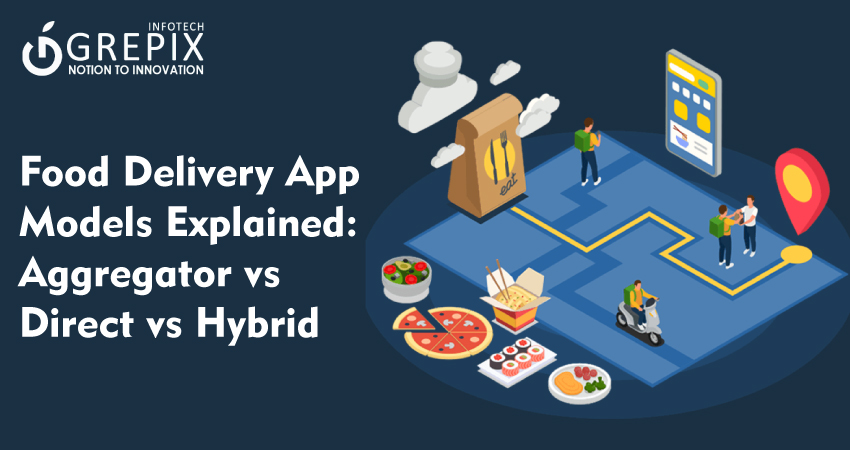Food Delivery App Models Explained: Aggregator vs Direct vs Hybrid
Fueled by convenience, personalization, and post-pandemic demand, the online food delivery market is projected to reach over $1.41 trillion globally by the end of 2025. The rise in app-based ordering has led to three dominant food delivery app models
Food delivery app models aggregator, direct-to-consumer, and hybrid are powering the multi-billion-dollar online food delivery industry in 2025. The aggregator model connects countless restaurants within branded marketplaces like Uber Eats and DoorDash, offering vast reach at a cost. Direct-to-consumer models empower restaurants to build brand loyalty and maximize profits, while hybrid models combine the best of both worlds. Real-life examples such as KFC’s direct app transformation and Swiggy’s custom logistics illustrate how choosing the right model can dramatically affect profitability, reach, and customer relationships. Read on to discover the best fit for your food delivery business, backed by case studies, real market data, and actionable insights.
Food Delivery App Models
Fueled by convenience, personalization, and post-pandemic demand, the online food delivery market is projected to reach over $1.41 trillion globally by the end of 2025. The rise in app-based ordering has led to three dominant food delivery app models:
- Aggregator
- Direct-to-Consumer
- Hybrid
Understanding these models is vital for restaurant owners, entrepreneurs, and investors aiming to win in the fast-evolving food delivery business.
Aggregator Model: Marketplace Power
What is the Aggregator Model?
The aggregator model is a digital marketplace connecting customers to a wide array of restaurants, resembling a sprawling virtual food court or mall. Customers browse menus, place orders, and the aggregator processes payments and manages delivery through its own logistic network.
Examples of Aggregator Apps
- Uber Eats
- DoorDash
- Grubhub
- Deliveroo
- Just Eat
These brands dominate global markets and attract millions of users daily, leveraging their massive marketing budgets for instant visibility.
How It Works
- Customers use the aggregator app to browse hundreds of restaurants.
- Orders are placed and processed by the app.
- The aggregator dispatches a delivery driver from its own network.
- Restaurants receive payment after the aggregator’s commission is deducted (often 15–30% per order).
Aggregator Model in 2025: Statistics & Trends
- Aggregator platforms process an estimated 60–70% of all online food delivery orders in North America and Europe.
- Restaurant commissions, marketing exposure, and turnkey logistics continue to attract new entrants despite margin pressures.
- Innovative tech, such as AI chatbots, drone delivery, and subscription models, is quickly reshaping aggregator operations.
Direct-to-Consumer Model: Own Your Brand
What is the Direct Food Delivery App Model?
In the direct-to-consumer app model, restaurants launch their own branded mobile apps for online ordering, commerce, and delivery management. This approach bypasses third-party platforms, maximizing branding, customer data ownership, and profit margins.
Examples and Case Study: KFC
Case Study: KFC Middle East
- KFC launched seven independent apps in various regions, reducing dependence on aggregator platforms from 90% to 50%.
- Resulted in 22% higher conversion rates and 60% more repeat purchases due to personalized engagement.
- The app now delivers 30,000+ orders per day, with improved customer lifetime value and direct user data access.
Other brands utilizing this model include:
- Domino’s Pizza: Internationally robust direct app, custom discounts, real-time order tracking, and loyalty features.
- Subway, Pizza Hut, McDonald's: Each invests in app experience and direct data-driven marketing.
How Direct Model Works
- Restaurant develops or licenses a branded food delivery app.
- App manages menu, promotions, ordering, and customer experience directly.
- Delivery is handled either in-house or through third-party partners, but all customer data, loyalty, and transaction flows remain with the restaurant.
Direct Model Pros & Cons
- Pros: Full control, customer data, loyalty-building, no platform commissions.
- Cons: Requires marketing spend, technology investment, and delivery management capabilities.
Hybrid Model: The Best of Both Worlds
What is the Hybrid Food Delivery App Model?
The hybrid model merges the aggregator marketplace’s reach with direct-to-consumer’s branding and profitability. Restaurants remain listed on select aggregator platforms for customer acquisition while aggressive promotion encourages customers to order directly in future.
Examples of Hybrid Strategy
- Restaurants list on aggregators but upsell direct ordering using flyers, incentives, and strategic menu pricing.
- Use third-party delivery partners for logistics in both app channels.
- Swiggy: Deployed custom logistics for reliability while maintaining aggregator visibility; increased repeat orders and healthy margins.
Case Study: Domino’s Hybrid Delivery
Domino’s leverages both its app (for branding and loyalty) and platforms like Uber Eats as an acquisition channel. Exclusive discounts motivate customers to shift from aggregators to the direct Domino’s app.
Hybrid App Models in 2025
- Up to 70% of successful restaurant chains use a hybrid model to maximize both reach and profitability.
- Innovative hybrid strategies include: dynamic pricing (higher for aggregator orders), loyalty programs, and tech integrations combining direct and marketplace data flows.
Pros & Cons: Which Food Delivery App Model Wins?
| Model | Pros | Cons | Examples |
|---|---|---|---|
| Aggregator Model | Massive reach, easy setup, outsourced logistics | High commissions, loss of customer data, brand dilution | Uber Eats, Grubhub |
| Direct-to-Consumer Model | Own customer data, higher profit margins, brand control | Marketing investment, delivery challenges | Domino’s, KFC |
| Hybrid Model | Balanced reach & control, flexible strategy | More complex operations, split focus | Domino’s, Swiggy, KFC |
Best Fit in 2025: Choosing Your Food Delivery Business Model
Food Delivery Business Model Selection Criteria
- New Restaurants: Aggregator model for instant visibility and early customer volume.
- Established Brands: Direct-to-consumer model for profit and loyalty, hybrid for maximizing growth.
- Multi-location Chains: Hybrid is superior, leveraging both aggregator reach for acquisition and direct apps for retention.
Trends and Insights
- Over 60% of global chains plan hybrid or direct models by 2025, aiming to capture lifetime customer value and minimize dependency on third-party platforms.
- AI, voice ordering, and subscription delivery services are boosting operational efficiency across all models.
Conclusion
Selecting the right food delivery app model aggregator, direct-to-consumer, or hybrid in 2025 can define your restaurant’s long-term success. While aggregator apps offer unmatched reach, their commission fees and lack of customer ownership make them best for startups seeking volume and visibility. Direct-to-consumer apps empower established brands to optimize profits, foster loyalty, and build data-driven relationships, but require investment in tech and marketing. Hybrid models combine reach and control, leveraging acquisition channels and direct retention tactics. Restaurants and food businesses must assess goals, market stage, and operational resources before choosing or blending these models.
FAQs
1. What is the aggregator food delivery app model?
An aggregator app connects consumers to multiple restaurants under one platform, handling ordering and often delivery logistics, while charging commission fees.
2. How does direct-to-consumer differ from the aggregator model?
Direct-to-consumer lets restaurants launch their own branded apps for full control of customer data, promotions, and margins, while the aggregator model relies on a marketplace for exposure.
3. What is a hybrid food delivery app model?
It’s a mix: restaurants use aggregators for customer acquisition and simultaneously promote their direct app for retention, largely using separate delivery logistics.
4. Are food delivery app models profitable in 2025?
Yes. With the market exceeding $1.41 trillion, all models are profitable if paired with smart strategy, margin protection, and tech innovation.
5. Which food delivery business model is best for new restaurants?
In 2025, new entrants typically benefit most from aggregator models for their reach and ease of adoption, then gradually transition to hybrid or direct apps for profitability.







